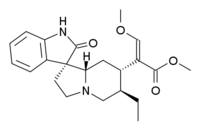draculic acid69
Bluelighter
- Joined
- Aug 22, 2019
- Messages
- 1,526
https://en.m.wikipedia.org/wiki/Incarvillateine has anyone tried this plant or its alkaloid? I'm wondering if it's easy to grow,how much you need,do u need to extract it etc etc
Very symmetrical isn't itNo idea whatsoever....but the chemical structure of this is absolutely gorgeous!!!
Extremely interesting plant as well!!!
Perfectly symmetrical which to my (didnt take chemistry in university) brain means that it can't be a chiral molecule.Very symmetrical isn't it
Until 10yrs ago no-one knew what kratom was. What about that liverwort stuff that's being sold online as a cannabis replacement.20yrs ago out of nowhere salvia divinorum popped up and was unfortunately touted as new drug get it now before it's made illegal but within a few yrs it was illegal.just coz it's new don't mean its shitif its used in traditional chinese medicine and hasnt been abused up to this point, i doubt it will have any recreational effects tbh
Outside of those isolated Aztec communities no-one else knew about salvia.outside Thailand no one knew what kratom was.not sure where this new shit is from but I'm sure there's some small population that knew about it for 1000yrs but only now is the general public finding out about itUntil 10yrs ago no-one knew what kratom was. What about that liverwort stuff that's being sold online as a cannabis replacement.20yrs ago out of nowhere salvia divinorum popped up and was unfortunately touted as new drug get it now before it's made illegal but within a few yrs it was illegal.just coz it's new don't mean its shit
salvia was used for thousands of years in mesoamerica as a psychoactive. kratom was used for at least hundreds of years in southest asia as a psychoactive. this has not.
We have, for example, a TCM plant containing a dissociative with 10x the affinity of dextrorphan, pretty much unknown but has been investigated for some properties not unlike other NMDA antagonists - might be that extraction is required because of very low alkaloid contents but it looks promising. Agree that unknown != worthless, for sure.Until 10yrs ago no-one knew what kratom was. What about that liverwort stuff that's being sold online as a cannabis replacement.20yrs ago out of nowhere salvia divinorum popped up and was unfortunately touted as new drug get it now before it's made illegal but within a few yrs it was illegal.just coz it's new don't mean its shit
We have, for example, a TCM plant containing a dissociative with 10x the affinity of dextrorphan, pretty much unknown but has been investigated for some properties not unlike other NMDA antagonists - might be that extraction is required because of very low alkaloid contents but it looks promising. Agree that unknown != worthless, for sure.
What plant and substance do you speak of?


The Naloxone challenge: tip a bucket of cold Naloxone over urself while high on opiates.
Rhynchophylline, it's contained in e.g. Uncaria rhynchophylla ("Gou Teng") but also, in trace amounts, in kratom. Made a thread about it in N&PD but maybe should have posted here, the other subsection unfortunately lost much of the activity of years ago.. Certainly something I need to research as soon as I have a stable home again, and the gear to do an extraction. It's available online and the indications sound good so far: Tremor, seizures, headache, spasms, irritability, bouts of anger. Then some others which don't readily fit into the profile: High blood pressure, vertigo, inflammation.
Personally I'd be more than happy with a legal, cheap, non-toxic NMDA antagonist which would give me the anxiolytic, relaxing, mood-stabilizing properties of very low dose e.g. DCK but of course a plant hole would be exciting.
But this litte gem here is now on my list too. An unknown, herbal opioid and adenosine agonist - promising!

Just that they always test for opioid activity with naloxone which is in fact an inverse agonist and has a bunch of effects even in opioid naive individuals. It blocks the antinociceptive effects of many drugs and is even listed as the antidote for DXM poisoning - naloxone does reverse dissociation to some degree, a very painful experience when I was on memantine (30 or 40mg/d, accumulates over some days so maybe like 60mg acutely) and accidentally exposed myself to <1mg of naloxone. And while memantine has painkilling qualities like all dissociatives, it isn't an opioid by any means but would act as one in the naloxone challenge.
Is a receptor binding assay so complicated to do that they rather use animals at the cost of inaccuracies?